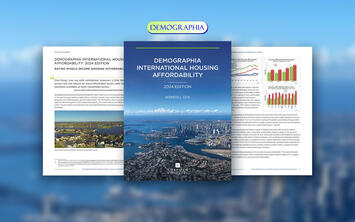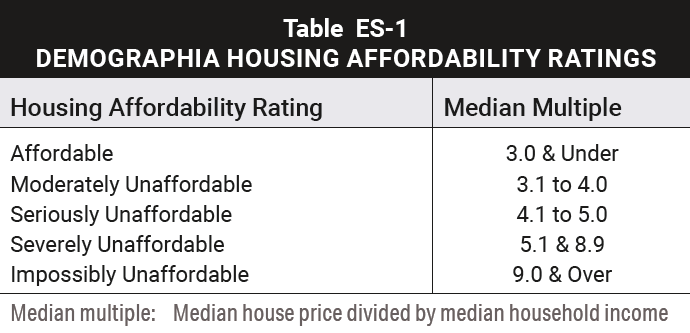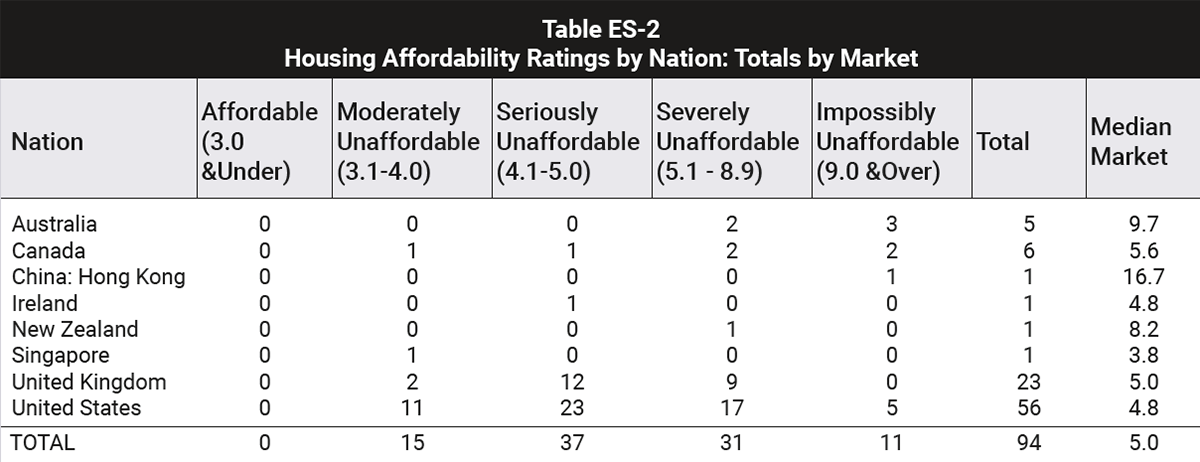
Demographia International Housing Affordability assesses housing affordability in 94 major markets across eight nations (Australia, Canada, China, Ireland, New Zealand, Singapore, United Kingdom and the, United States). The 2024 edition focuses on data from the third quarter of 2023.
Key Points
Ratings: The report uses a median price-to-income ratio (“median multiple”) to determine affordability.
 Affordability Categories: Housing markets are rated from “affordable” to “impossibly unaffordable” based on their median multiple (Table (ES-1).
Affordability Categories: Housing markets are rated from “affordable” to “impossibly unaffordable” based on their median multiple (Table (ES-1).
Geography: Housing markets are labor markets (which are also metropolitan areas or functional urban areas), largely defined by the “commuting shed.” Housing affordability comparisons can be made, (1) between housing markets (such as a comparison between Adelaide and Melbourne) or (2) over time within the same housing market (such as between years in Adelaide).
Variations within Nations: The report emphasizes that affordability often varies significantly between markets within the same country. National averages aren’t always representative.
Housing affordability in 2023 is summarized by nation in Table ES-2.
International Housing Affordability in 2023: In the US, the most affordable market was Pittsburgh (PA), with a median multiple of 3.1, followed closely by Rochester (NY) and St. Louis (MO-IL) at 3.4, with Cleveland (OH) at 3.5. Rounding out the most affordable ten markets also includes one Canadian market, Edmonton, plus Buffalo (NY), Detroit (MI), Oklahoma City (OK) at 3.6, Cincinnati (OH-KY-IN) and Louisville (KY-IN) at 3.7. Singapore at 3.8 was also moderately unaffordable, along with, in the UK, Blackpool and Lancashire, and Glasgow at 3.9.
The Housing Affordability Crisis: Causes and a Path Forward
Middle-income households face rapidly escalating housing costs, which is the primary cause of the present cost-of-living crisis. For decades, home prices generally rose at about the same rate as income, and homeownership became more widespread. But affordability is disappearing in high-income nations as housing costs now far outpace income growth. The crisis stems principally from land use policies that artificially restrict housing supply, driving up land prices and making homeownership unattainable for many.
Urban containment policies (greenbelts urban growth boundaries, densification) are designed to limit sprawl and increase density. While well-intentioned, these policies severely constrict the land available for housing. In constrained markets, higher land values translate to dramatically higher house prices.
Economic Dynamics
Land values naturally increase closer to urban centers. Urban containment policies are associated with abrupt value spikes at established boundaries. Research confirms this, finding land prices inside urban containment boundaries can be 8-20 times higher than outside.
New Zealand's Reforms: A Model
New Zealand provides a hopeful path forward. Recognizing the crisis is rooted in high land values, new policies are proposed to open up sufficient land to accommodate demand.
A Focus on People, Not Places
The housing crisis demands prioritizing the well-being of people over abstract planning ideals. The planning orthodoxy, while aimed at improving cities, has worsened affordability. This undermines the economic opportunity essential for thriving middle- and lower-income households.
Elaboration and sources are in the full report. Click here to read and download the full report.
Wendell Cox is principal of Demographia, an international public policy firm located in the St. Louis metropolitan area. He is a founding senior fellow at the Urban Reform Institute, Houston, a Senior Fellow with the Frontier Centre for Public Policy in Winnipeg and a member of the Advisory Board of the Center for Demographics and Policy at Chapman University in Orange, California. He has served as a visiting professor at the Conservatoire National des Arts et Metiers in Paris. His principal interests are economics, poverty alleviation, demographics, urban policy and transport. He is co-author of the annual Demographia International Housing Affordability Survey and author of Demographia World Urban Areas.
Mayor Tom Bradley appointed him to three terms on the Los Angeles County Transportation Commission (1977-1985) and Speaker of the House Newt Gingrich appointed him to the Amtrak Reform Council, to complete the unexpired term of New Jersey Governor Christine Todd Whitman (1999-2002). He is author of War on the Dream: How Anti-Sprawl Policy Threatens the Quality of Life and Toward More Prosperous Cities: A Framing Essay on Urban Areas, Transport, Planning and the Dimensions of Sustainability.
Lead image: Demographia International Housing Affordability — 2024 Edition cover photo from New Matilda used under CC 2.0 License.













